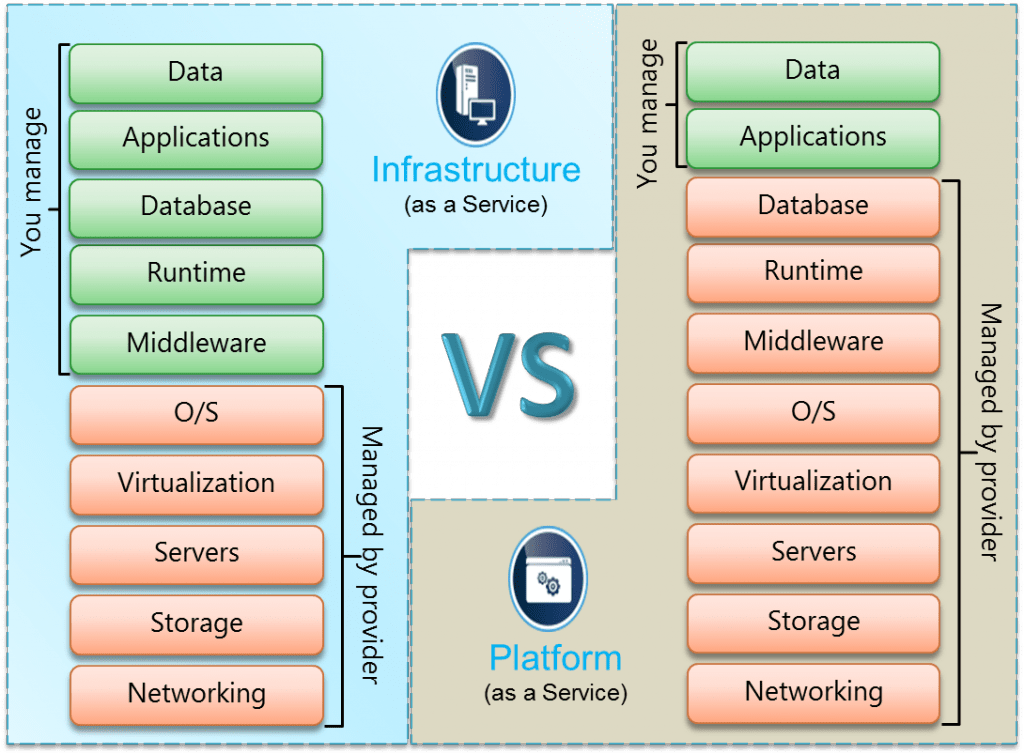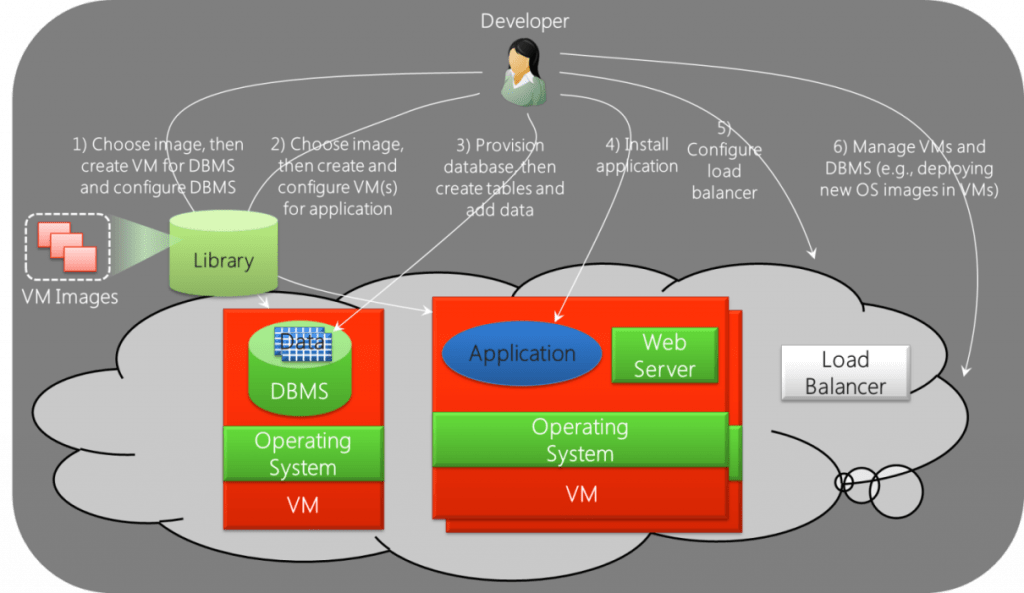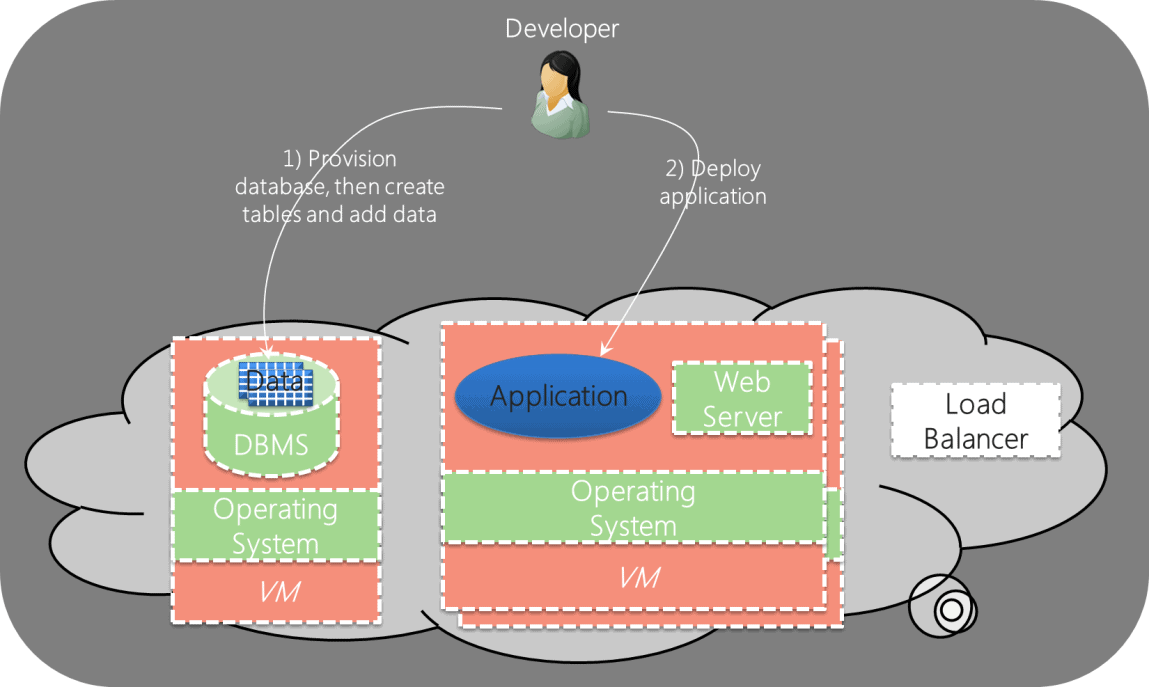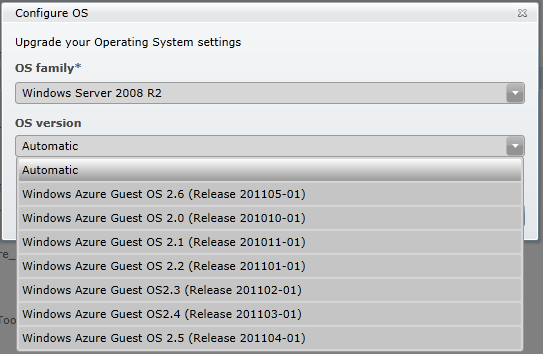In my previous article, I discussed the basic concepts behind Cloud Computing including definitions, characteristics, and various service models. In this article I will discuss service models in more detail, and in particular the comparison between IAAS and PAAS from a developer’s standpoint.
I’m using two giant cloud players for illustrative purposes: Amazon Web Service representing IAAS and Windows Azure Platform representing PAAS. Nonetheless, please be informed that the emphasis is on the service models and not the actual cloud players.
Figure 1: IAAS VS PAAS
Infrastructure as a Service (IAAS)
IAAS refers to the cloud service model that provides on-demand infrastructure services to the customer. The infrastructure may refer to rentable resources such as computation power, storage, load-balancer, and etc.
As you can see on the left-hand side of Table 1, the IAAS provider will be responsible for managing physical resources, for example network, servers, and clustered machines. Additionally, they typically will also manage virtualization technology enabling customers to run VMs (virtual machines). When it comes to the Operating System (OS), it is often arguable whether it’s managed by the provider or customer. In most cases, the IAAS provider will be responsible for customer VM Images with a preloaded OS but the customer will need to subsequently manage it. Using AWS as an example, AMI (Amazon Machine Image) offers customers several types of Operating Systems such as Windows Server, Linux SUSE, and Linux Red Hat. Although the OS is preloaded, AWS will not maintain or update it.
Other stacks of software including middleware (such as IIS, Tomcat, Caching Services), runtime (JRE and .NET Framework), and databases (SQL Server, Oracle, MySQL) are normally not provided in the VM Image. That’s because the IAAS provider won’t know and won’t care what customers are going to do with the VM. Customers are responsible for taking care of them. When all of the above mentioned software has been settled, customers will finally deploy the application and data on the VM.
Step-by-step: Setting-up an Application on IAAS Environment
To convey a comprehensive explanation, I am going to illustrate the steps involved when setting up an application in an IAAS environment. For that, I’m borrowing a slide from a presentation by Mark Russinovich, at the BUILD conference. This illustration explains how a typical IAAS provisioning model works.
Figure 2: Setting up an App
Considering a common scenario when you have finished developing a multi-tier application, you as the developer will need to deploy it to the cloud. The application will need to be hosted on a Web Server and an RDBMS database. For IAAS, here are the typical steps:
1. Preparing Database Servers
Select the VM Images from the VM Images library. The VM Image will then get provisioned and launched. If DBMS software is not provided, you will need to install DBMS on your own.
2. Preparing Web / Application Servers
Select VM Images from the library to get provisioned and launched. If the web/app server/runtime aren’t installed, you’ll need to install them by yourself.
3. Provisioning a Database and Its Objects
The next step is about provisioning the database, including configuring the data files, log files, security, etc. Then you create the tables and add data to it.
4. Deploying Your Application
Next you take the application that you’ve developed and deploy it to the Web Server.
5. Configuring load-balancer
When you need to host your application on multiple instances, you may also need to configure things such as the IP Address for each instance and load balancer.
6. Managing Your VMs and DMBS
The final step is about managing the VMs. For example, when there’s an update or service pack on the OS, the IAAS provider will not automatically do it for you. Instead, you may need to do it by yourself.
Platform as a Service (PAAS)
Now, let’s jump into another cloud spectrum, “PAAS”, to see how it differs. In PAAS, the provisioning model is about an on-demand application hosting environment. Not only managing the component like an IAAS provider would, a PAAS provider will also help customers manage additional responsibilities such as OS, Middleware, Runtime, and even Databases, as can be seen on the right-hand side of Table 1.
In other words, you can think of PAAS as renting a stack of software, hardware, and infrastructure. Customer will just need to bring the application and data and they are ready to go.
Step-by-step: Setting-up an Application on PAAS Environment
For PAAS, given that the database server, VM, and web server VM are readily provisioned, you just need to do two steps, as illustrated by another slide from Mark Russinovich.
Figure 3: Provision and Deploy
1. Database Provisioning
You might need to indicate where (which region) your virtual DB Server is provisioned, but you don’t have to install a bunch of DBMS software on your own. You will need to provision the database, create tables, and add data.
2. Deploying Your Application
This is a similar step applicable to IAAS, you will still need to deploy your application on the PAAS cloud environment.
How about the load-balancer? Take Windows Azure as example, it will all automatically be configured and ready to take the traffic, and everything else will be automatically managed. You don’t have to worry about IP Addresses or a load-balancer.
How about maintaining VMs? The DBMS and Web Server VM will be maintained by the provider. For example:
- If the VM where your application is hosted has any hardware issues, the provider should be able to detect the failure and rectify it immediately to make sure that your application will stay up and running. In Windows Azure, Fabric Controller will be the component handling these kinds of issues.
- If there are new updates or patches on the Operating System, the provider will make sure that the VM your application sits on is always updated. For example: Windows Azure uses “Guest OS Version” to differentiate service updates. Of course you can also choose to stick to one version or auto-update.
Figure 4: Configuration
Summary
To summarize, we have investigated different service models and provisioning steps of IAAS and PAAS solutions. PAAS providers indeed take on much more responsibility for your solution than an IAAS provider would. On the other side, IAAS may offer more flexibility at lower level (example: public IP addresses, load-balancer, etc.).
There’s no one-size-fits-all here. As a developer or architect, you should understand a customer’s need and determine the correct model to get the best possible outcome.






Load comments